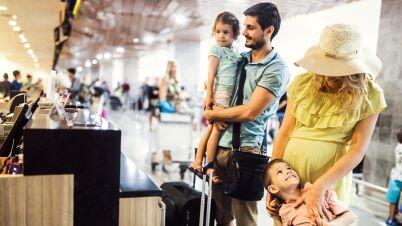Marred by unprecedented disruption, the hospitality industry is now adapting to reap the rewards of the new normal.

Dealing with disruption
In 2020 the pandemic brutally ravaged the hospitality sector worldwide. Airlines, hotels, cruises and ferries, restaurants, and theme parks, among others, were devastated by low, and in some cases, zero activity. In May 2020, the hotel occupancy rate in Europe saw the most dramatic effects of the virus, with occupancy rates of 13.3 percent — compared to the previous year this figure dropped by 82.3 percent . Additionally, the IATA WATS 21 reports identified a plunge in the Revenue Passengers Kilometers (RPK) to nil in April 2020 .
With the hospitality industry plummeting into the red at lightning speed, worldwide, operators were left to cope with strict regulation changes and unpredictable financial support that varied from country to country.
Finding its footing
As the medical profession and politicians worked to contain the spread of the virus until a vaccine or cure could be found, the hospitality industry began to adapt. In some countries, and in some sectors, hospitality providers began operating under previously unimaginable conditions.
Rapidly implemented new guidance including mask wearing, mandatory PCR testing, temperature check/thermal cameras, new border crossing regulations, quarantine measures, capacity limits in venues, social distancing and contactless interactions, flexible cancellation policies, and more, were accepted by professionals and customers, as the industry adapted to the new normal.
As measures were adopted, Q3 2020 began to see a new tourism revenue mix emerge encouraged by new offers:
• International travel was limited to few countries or regions
• Business travel, which used to be the best profit generator, plunged to nil while domestic leisure started to rise with the upcoming summer break
• Staycations and daycations became the response to the lock-down situation
• Digital nomads relocated in cool places
• The emerging bleisure trend ― a combination of business and leisure ― accelerated Gen Y’s expected work-life balance
• Hotels transformed to accommodate quarantine facilities, medical staff accommodation and even hospital requirements
There was also a significant shift in the air transport sector. With eCommerce booming, the sector faced a massive growth in cargo, while passenger aircrafts sat on the tarmac. Even here though, the industry rallied with new ideas as companies bought old passenger aircraft to convert to cargo.
Hospitality in the new normal
While some analysts foresee a return to 2019 figures by 2023, no one really knows for sure as there are no existing similar models from the past upon which to base these predictions. What’s clear is the world is adapting, as is its resiliency to deal with viruses, geopolitical tensions, and other hazards we encounter every day.
Whatever happens with the virus, we are all participants in this new normal — in the way we work, consume, interact, and travel. And, change is not new to us. In the past, incidents such as 9/11 which overhauled air transport, and technology that enabled the emergence of eCommerce in the retail space, and taxi and food delivery with uber-like services have forced us to adapt to new ways of doing things.
So, what will the new normal for the hospitality industry look like? Some practices adopted during the pandemic have already started to fade away, the question is ― what will remain? And, what challenges will they bring?
4 Trends to watch
Following are four key trends we believe will influence the hospitality sector moving forward:
1. Less business travel: Many internal meetings or courtesy visits that used to take place in-person are now conducted online. This has had a major impact on airlines and hotels, as business travelers globally that use the best airlines and hotels generate more profit for the industry. Less business travel means we will see a shift in revenue balance between business and leisure travel. While corporate travel is easier to anticipate as it has traditionally been based on a regular volume of bookings through the same airlines and hotel chains, leisure travel is much more volatile especially with options such as Airbnb, low cost airlines, and Online Travel Agencies.
2. Trip stacking: You may have already heard about it. During the pandemic, airlines and hotels offered more flexible conditions to cancel bookings. To hedge their bets, travellers would book several trips over the same time period and then cancel, as late as possible, the one(s) that didn’t work for them. For example, booking a 5-day family trip in Egypt would be plan A, and a week at a resort in the home country would be plan B. If things changed the traveller would cancel plan A and to move to Plan B. While the flexibility works for the traveller, it is not so kind to the hotel and airline industries. As uncertainty lingers travellers are still not quite comfortable making non-refundable reservations. Companies that remove flexible cancellation risk losing reservations to competitors.
3. Bleisure: Bleisure describes travel that combines both business and leisure. With the spike in working from home the barrier between work and personal life is more blurred than ever. Though the concept is not new, bleisure is now becoming a current practice, and even a perk, where companies and employees see mutual benefits, similar to working from home.
Whether bleisure means working during your vacation, or taking your family with you on a business trip with some time off to relax, bleisure is challenging hoteliers with new requirements including: the type of hotel travellers want to stay at; the duration of the stay; preferred destinations; and guest services, among others. Some chains like Marriott or Accor have already acknowledged the trend and have embraced it as an opportunity.
4. Online Travel Agencies (OTAs) – a key player: Over the past decade, OTAs have become a significant player that hotels cannot disregard if they want to optimise their bookings. Unfortunately, this easiest way to sell rooms comes at a cost. OTAs are able to justify the 25% (on average) they charge hoteliers, based on their superior digital engagement, the billions invested in advertising, and their growing success.
Guest using OTAs benefit from a larger choice of places to stay, easy price comparisons, and a consistent and superior digital experience — all for free!
As OTAs become more global, the massive traveller data they collect will position them to move into the traditional travel agency space of managing the entire traveller journey providing airline tickets, car rental, coordinating the hotel stay, as well as entertainment.
Going forward
The world has changed. Previous booking and occupancy patterns are gone forever which means forecasting occupancy will be very difficult. Hotels are adapting room rates based on their bookings and the bookings of surrounding hotels in the same category. Dynamic Pricing enabled by Revenue Management Systems (RMS) are helping hoteliers maximise sales and profits every day. Similarly, airlines are adjusting their price-per-seat in real-time based on remaining available seats for a given flight, and prices from competing airlines. Whatever the post-pandemic world looks like, adapting to address the four key trends will enable the hospitality industry to move forward through what has truly been an unprecedented time of disruption.
The good news is the hospitality industry is positioned to take advantage of technology trends and finance options that existed in other sectors prior to the pandemic. Simple, predictable, worry-free solutions that don’t require major capital investments will be critical to provide flexibility and agility going forward. Cloud-based solutions and Software as a Service (SaaS) models will enable the hospitality industry to succeed as we settle into the new normal.
Latest Blogs

Supply chain resilience and business adaptability
Strategic supply chain resilience and business adaptability to thrive in the face of adversity

Solve education challenges with a modern campus network
A modern campus network helps streamline operations, reduce costs, and offers a safe and caring place to work and study.

Revitalise education with a modern campus network
A modern, campus-wide network upgrade aligns capabilities with academic, research and business priorities today and tomorrow.

Education today: Why modernising campus networks is a must
Educational institutions worldwide must modernise their networks to meet today’s new requirements.

